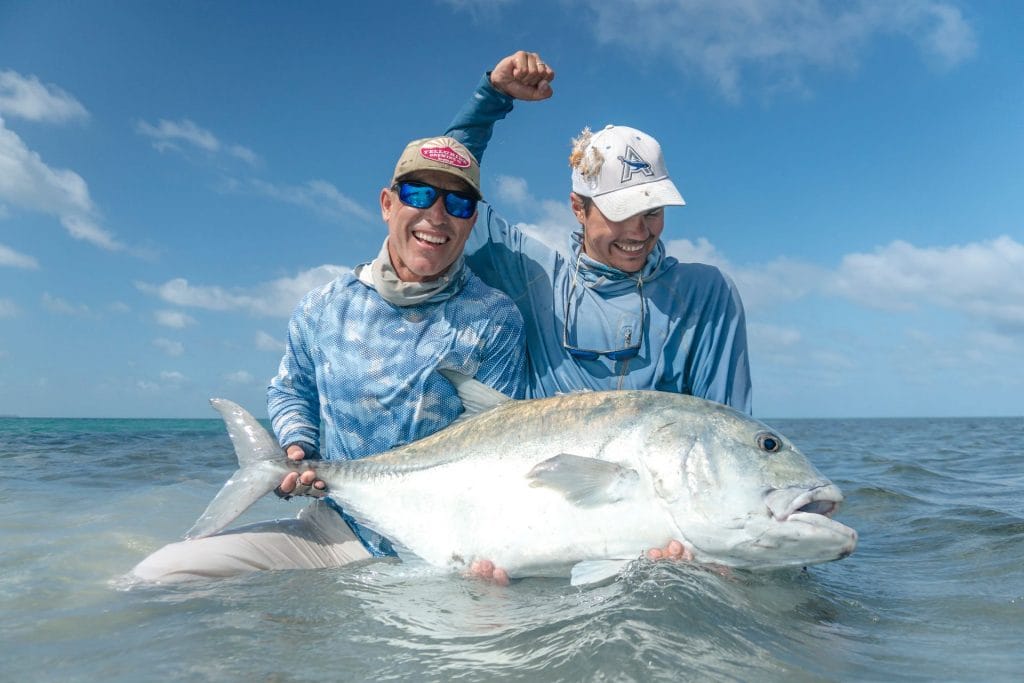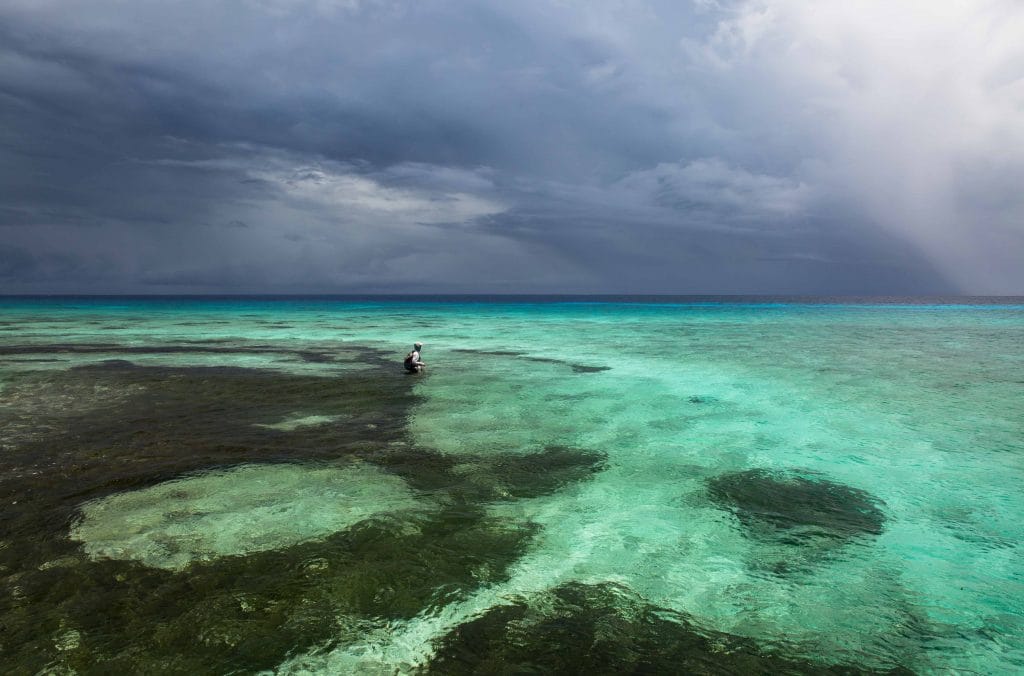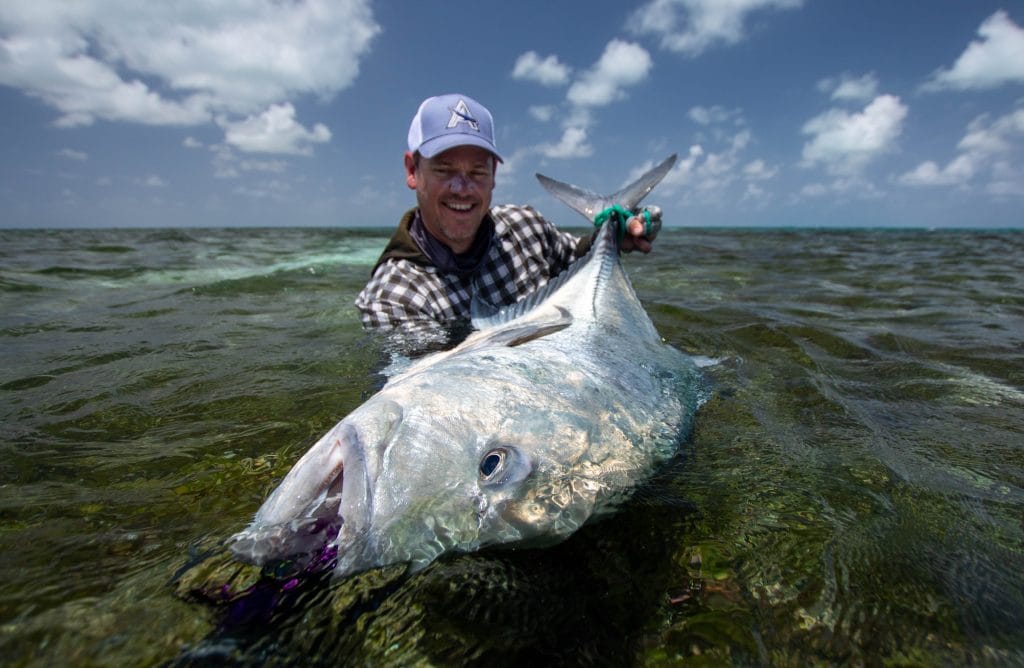They are dubbed “the gangsters of the flats”, and for a good reason. The giant trevally is arguably one of the most exciting species that you can target on the fly. As an angler, you can encounter them in many fly fishing scenarios, including surf zones, white sand and turtle grass flats, and deeper water offshore.
Fish facts
- The Giant Trevally is the largest trevally species with the all-tackle world record weighing 72.80kg caught in Japan. In the Indian Ocean, fish are generally in the range of 70 – 130cm. On the flats, a GT of 100cm plus is considered a trophy.
- The species is the epitome of an apex predator and opportunistic hunter. GTs prey on various food items and are rarely selective, including small fish, crustaceans, squid, birds, small turtles.

Equipment for giant trevally
- 9-foot 12wt rods is the standard rod that most use, but for fishing on white sand and in the lagoon a 11wt can also be excellent.
- Lines must be tropical/warm water fly lines to match the recommended rod. The line must have a core strength of at least 50lb. Airflo GT, Cortland GT/Tuna and Rio GT are all good lines. Factory loops are generally not strong enough for GT fishing and should be cut off and replaced with a 50lb+ braided loop on both the reel end and leader end of the fly line.
- The best reels for Giant Trevally should have the following features: fast line retrieval, a drag system designed to handle wet wading in saltwater, and a minimum backing capacity of 300 yards of 80lb gel spun or casting braid. Hardy Fortuna Z, Shilton SL7, Abel Super Series, Mako are all reels that have stood the test of time and work well for this amazingly strong fish. The fly line should be attached to the backing with a loop to loop connection. A double looped bimini twist in the backing stops the thinner line cutting through the fly line.
- Leaders for Giant Trevally are a simple. 8-9ft of 130lb or 1mm soft monofilament, is the standard leader for most situations, but on the white sand fishing 80lb or sometimes 60lb monofilament can be an advantage. The leader is joined to the fly line with a loop-to-loop connection. Both a perfection loop and a improved homer rhodes are excellent knots. The same knots can be used to attach the fly.
- Some popular flies for Giant Trevally include GT Tan brush fly, GT Black brush fly, Olive Semper, and Black & Purple Semper. All tied on size #6/0 or #8/0 Gamakatsu SL12S hooks.

At home practice
Prepare – Practice casting with a 12wt before your trip
One of the most critical elements of a successful fly fishing adventure to the wild flats of the Indian Ocean is your ability to deliver the fly to your target species quickly.
Practice your casting at home or with a casting instructor before your trip. Twelve weight fly rods and large flies make casting challenging at the best of times. This single yet hugely important thing you can do before your trip adds enormous value to your fly fishing experience on the flats.
Presentation on the flats
Fly fishing in saltwater exposes anglers to a world of moving targets. Few fish will stay stationary for very long. Giant trevally are almost always found while on the move. A trick is to imagine that you’re trying to cast at someone running across your garden. After a few attempts, you will realise that you need to aim a yard or two in front of your target. The same principle applies while fly fishing for GTs. In most situations, you will want to land your fly 15ft in front of the fish and behind the line where it is travelling. The ideal presentation is when you have given yourself time to allow the fish to swim onto the fly before it recognises it as a potential prey item. Once the fish is 5ft from your fly, make one medium to long retrieve. Often the fish will light up. If this is the case, look at your hands and continue long stips until the line tightens to the extent that you can’t strip anymore. If this is not the case, you will have to read the fishes body language more carefully and match the speed of the stips to how quickly the fish is moving towards your fly. The length of the strip is essential. Too often, people strip too short, and although they are moving quickly, the fly isn’t.
Fly fishers who catch a lot of fish all have one thing in common. They do what they can to limit the number of variables in catching a fish to a minimum. The KISS principle (Keep It Simple Simon) should be applied to fly fishing, especially while hunting for Giant Trevally. If you have spotted the fish in time and the angle of the wind or the distance to the fish is too great, move into a better position so that you can make the correct presentation.
Line management
Be aware of where your line has gathered on the sand, in the water, or on the boat. It may seem like a chore to continually manage your fly line, but after a while, it will become second nature, and you will find yourself doing it without giving it much thought. Making sure your fly line is free of potential snags like your feet, coral, or a latch in the boat is often the difference between landing your dream catch or watching it swim by.

Explore
One of the most extraordinary things about flats fishing in the Indian Ocean is the freedom to explore some of the most pristine and abundant fisheries on the planet. You will be on foot, on the flats, or an island; use your intuition. Your guide has chosen the area you are fishing at that time of the day for a reason. He knows fish should be there. If you see something that looks good or “fishy”, move to it, watch it, and make a cast or two if you are not sure. The number of trophy giant trevally landed by guests who have had a “feeling” and wandered off to investigate is high and proves that those who have the intention to explore catch fish.
Have fun
The unique fly fishing targets available might have been the primary reason you’ve travelled halfway around the world to visit a particular destination. Still, it’s important to remember that you’re going to spend six whole days in some of the wildest environments on our planet. The sights, experiences, heartbreaks, and successes are better shared with a good friend or like-minded angler. We love the outdoors, and that is why we have chosen to spend our time in these settings. We challenge you to have fun, enjoy a drink with your fishing buddy and look around; you are going to experience the rarest of resources – ecosystems fully intact and undisturbed by man.
Where is the best giant trevally destination for you?
Several destinations offer anglers the opportunity to cast a fly at giant trevally. If you would like more information please contact Charlotte Chilcott or Peter McLeod or call us on +44 1980 847389. Alternatively click HERE if you would like us to contact you.
